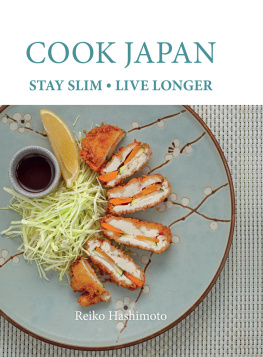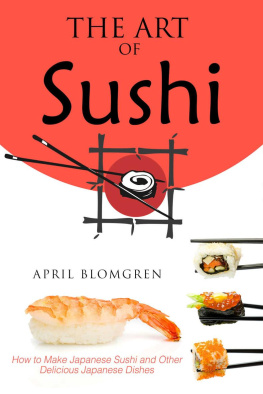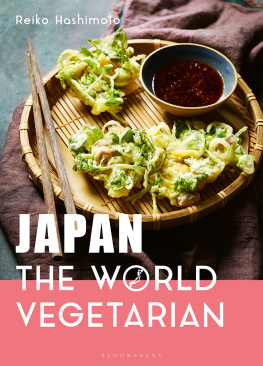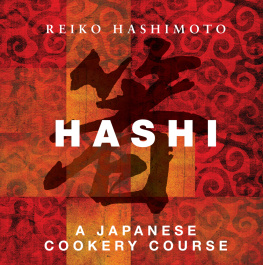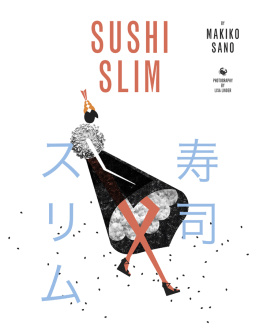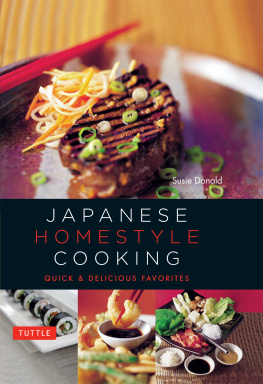

Absolute Press
An imprint of Bloomsbury Publishing Plc
50 Bedford Square | 1385 Broadway |
London | New York |
WC1B 3DP | NY 10018 |
UK | USA |
www.bloomsbury.com
First published 2017
Reiko Hashimoto, 2017
Photography Jodi Hinds, 2017
This electronic edition published in 2016 by Bloomsbury Publishing Plc
Bloomsbury is a registered trademark of Bloomsbury Publishing Plc
Reiko Hashimoto has asserted her right under the Copyright, Designs and Patents Act, 1988, to be identified as Author of this work.
All rights reserved
You may not copy, distribute, transmit, reproduce or otherwise make available this publication (or any part of it) in any form, or by any means (including without limitation electronic, digital, optical, mechanical, photocopying, printing, recording or otherwise), without the prior written permission of the publisher. Any person who does any unauthorised act in relation to this publication may be liable to criminal prosecution and civil claims for damages.
No responsibility for loss caused to any individual or organization acting on or refraining from action as a result of the material in this publication can be accepted by Bloomsbury or the author.
British Library Cataloguing-in-Publication Data
A catalogue record for this book is available from the British Library.
Library of Congress Cataloguing-in-Publication data has been applied for.
ISBN: 978-1-4729-3323-2 (HB)
ISBN: 978-1-4729-3324-9 (eBook)
ISBN: 978-1-4729-3325-6 (ePDF)
To find out more about our authors and their books please visit www.bloomsbury.com where you will find extracts, author interviews and details of forthcoming events, and to be the first to hear about latest releases and special offers, sign up for our newsletters.
Publisher: Jon Croft
Commissioning Editor: Meg Avent
Art Director and Designer: Kim Musgrove
Project Editor: Emily North
Photographer: Jodi Hinds, www.jodihinds.com
Photographers Assistants: Tristan Fennell & Pablo Antol
Crockery for photography: Courtesy of Doki Japanese
Tableware, www.dokiltd.co.uk
Calligraphy: Reiko Hashimoto
Researcher: Chloe Hodge
Copyeditor: Kate Wanwimolruk
Home Economist: Elaine Byfield
Proofreader: Zoe Ross
Indexer: Zoe Ross
PREFACE
Seventeen years ago I moved to London from Japan and after three years I began my cookery school, Hashi Cooking. I teach students ranging from complete beginners to professional chefs how to make authentic Japanese recipes, with a little fusion inspired by my travels around the world.
I had never dreamt that my teaching could reach the level that it is now, but it seemed to develop naturally. I enjoy interacting and connecting with people. Its always been in me. Teaching my culinary heritage and Japanese cooking skills is an extremely important part of my life and I feel extremely blessed to do what I am most passionate about.
Growing up, I was fortunate enough to have had a mother who cooked fresh food for each and every meal, every day. I remember, as a child, I would wake up and go downstairs to the familiar sound of grating in the kitchen. This was my mother, shaving a solid piece of dried and smoked bonito fish to make the flakes for dashi stock. Each day she would shave the fish to obtain the freshest bonito flakes that were then made into dashi stock for miso soup, which was served at breakfast. These days most home cooks use instant dashi stock powder to make this soup, but if you were brought up with the fresh, real flavour it is hard to come to terms with these fast, modern alternatives.
My family continue to live in Kyoto where I grew up, a city in which we always had an abundance of seasonal mountain vegetables. Like most Japanese chefs, I learnt to cook with the seasons to achieve the best flavours. I return to Japan once a year, often in the spring or autumn as this is when my favourite ingredients are available. Early in the spring, I look out for the woody and nutty flavour of freshly picked bamboo shoots, while in autumn I am drawn towards matsutake mushrooms, also known as the Japanese truffle. Simmered lightly in dashi stock and served with the citrus fruit yuzu to cut through their earthy flavour, these mushrooms taste divine.
It is these moments of sheer joy that have developed my dedication to real Japanese flavours, and to introduce them to others through my teaching. At its core, my teaching style looks to challenge the myth that Japanese cooking is complex and mysterious. I want to break down these barriers by providing easy-to-follow recipes and cooking methods that can be painlessly adapted to the Western kitchen, as well as explaining the versatility and nutritional properties of unfamiliar ingredients.
The Japanese Diet
As a health-conscious chef, I have long been aware of the specific health benefits of the Japanese diet. Japan boasts one of the highest life expectancies in the world, and only 3.6 per cent of the Japanese population have a body mass index over 30, which is the international standard for obesity, compared to 32 per cent of Americans. The reasons for this are undoubtedly the diet, with many Japanese people subscribing to the notion eat with your eyes a nod to the importance of colours, crockery and food presentation.
Typically, Japanese meals consist of an array of textures and flavours, which are eaten slowly and, in comparison to the western diet, contain fewer fats or processed ingredients, and far less dairy and meat. Versatile ingredients such as miso and two of my personal favourites seaweed and tofu contain an array of vitamins and minerals that promote excellent health, and most importantly lead to mouthwateringly good food. Tofu is revered in Japan, and Kyoto in particular is famous for the delicacy of its tofu, but in the west this ingredient is often neglected or considered vegetarian-only. Tofu is something I try to eat every day during my visits to Kyoto, as it is beautifully clean and rich and you can find a huge variety of types from different regions. I suppose we see tofu as the French see cheese. Although it may be unlikely to find tofu of quite the same quality in the UK, the recipes in this book, I hope, will teach an appreciation of this unique and delicious ingredient.
Offering authentic and clearly explained recipes, this book is your gateway to the cuisine that gives Japan one of the lowest obesity rates and longest life expectancies in the world. It also offers you an insight into the food culture of Japan, which has remained so close to my heart.
INTRODUCTION
COOK JAPAN
Food really is central to Japanese culture. From mothers creating bento boxes each day for their children to take to school to friends gathering around a nabemono (hotpot) for a shared meal or visiting sushi bars to have your food prepared in front of your eyes food is everywhere.

